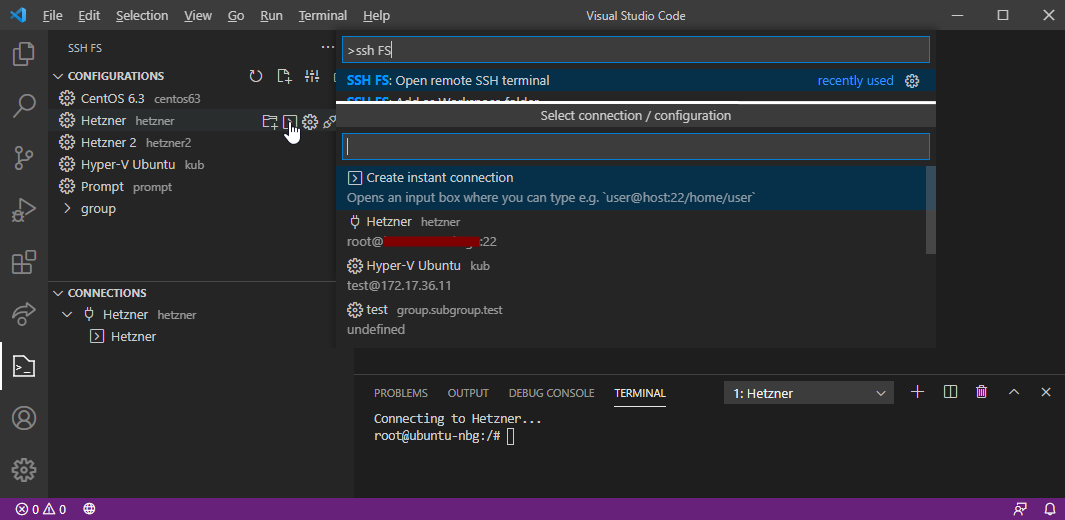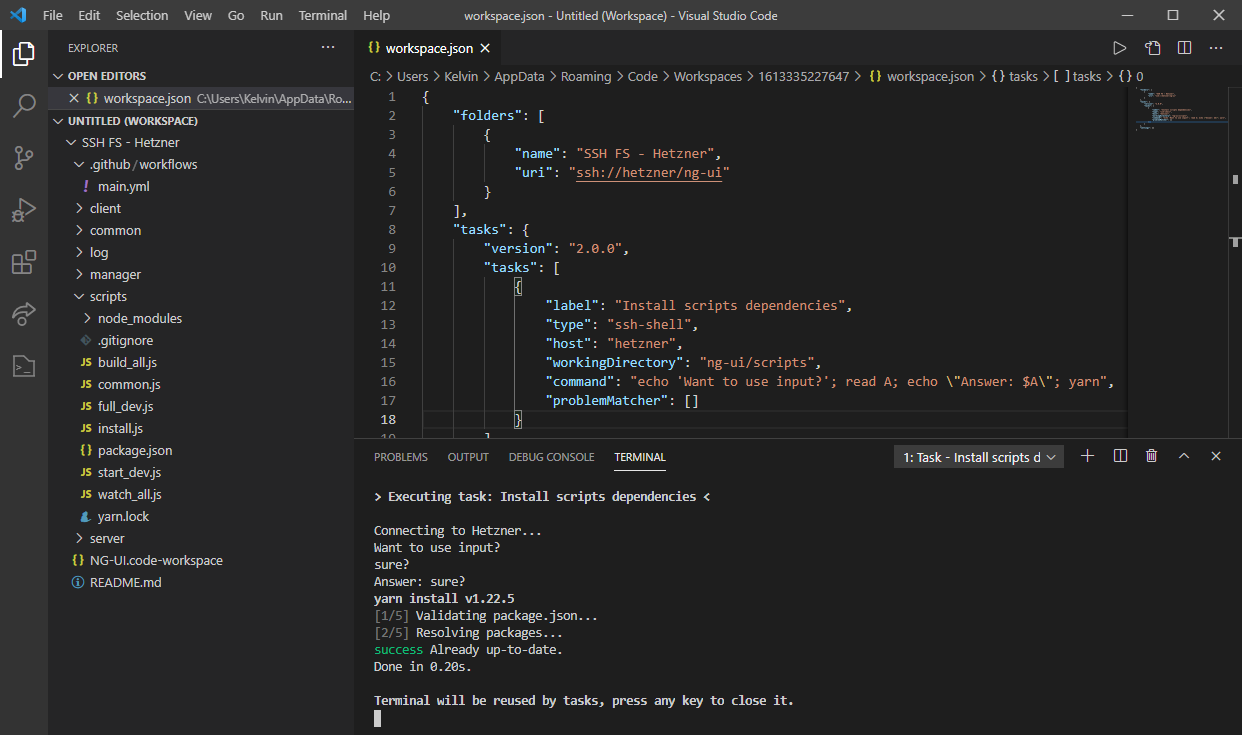This extension allows mounting remote folders as local workspace folders, launch integrated remote terminals and run ssh-shell tasks.
The built-in config editor makes it easy to create and edit configurations:

The config editors stores this, by default, in your User Settings (settings.json) as:
"sshfs.configs": [
{
"name": "hetzner",
"putty": "Hetzner",
"label": "Hetzner",
"hop": "hetzner2",
"root": "/root"
}
],This config is configured to copy settings (e.g. username, host, ...) from my PuTTY session. Due to me having loaded my private key in Pageant (PuTTY's agent), this config allows me to create a connection without having to provide a password/passphrase. It also specifies that all file operations (ssh://hetzner/some/file.js) are relative to the /root directory on the server.
Configurations are read from your global User Settings, the current workspace's settings, and any JSON files configured with sshfs.configpaths. Even when the workspace overrides this setting, the globally-configured paths will still be read. The workspace versions do have higher priority for merging or ignoring duplicates.
Using a simple button or the command palette, a remote terminal can be started:

Uses $SHELL by default to launch your default user shell. A config option exists to change this, e.g. "ksh -" or "exec .special-profile; $SHELL"
If a connection is already opened for a configuration, there is no need to reauthenticate. As long as the configuration hasn't changed, existing connections (both for workspace folders and terminals) will be reused.
A new task type ssh-shell is added to run shell commands remotely:

The task terminal opens a full PTY terminal on the server.
Using a simple button or the command palette, we can mount a remote workspace folder as a regular local workspace folder:

Same configuration used as from the Config editor above.
This works seamlessly with extensions using the vscode.workspace.fs API (added in VS Code 1.37.0), although not all extensions switched over, especially ones making use of binary files.
As can be seen, right-clicking a remote directory gives the option to instantly open a remote terminal in this directory.
The extension supports any ssh:// URI. I actually opened ssh://hetzner/ng-ui as my folder, which resolves to /root/ng-ui on my remote server. By default, the button/command opens ssh://hetzner/ which would then mount /root, as that is what my Root config field is set to. You can set it to whatever, including ~/path.
The extension comes with a bunch of other improvements/features. Internally the ssh2 package is used. The raw config JSON objects (as seen in Config editor) is, apart from some special fields, a one-on-one mapping of the config options supported by this package. Power users can edit their settings.json to e.g. make use of the algorithms.cipher field to specify a list of ciphers to use.
Some other features worth mentioning:
Active connections are reused to minimize prompts. A connection gets closed if there's no terminal or file system using it for over 5 seconds.
Several proxy types (SSH hopping, HTTP and SOCKS 4/5) are supported:
SSH Hop refers to using another configuration to hop through, similar to OpenSSH's ProxyJump:
The extension supports using a custom sftp subsystem command. By default, it uses the sftp subsystem as indicated by the remote SSH server. In reality, this usually results in /usr/lib/openssh/sftp-server being used.
The SFTP Command setting allows specifying to use a certain command instead of the default subsystem. The SFTP Sudo setting makes the extension try to create a sudo shell (for the given user, or whatever sudo defaults to) and run SFTP Command (or /usr/lib/openssh/sftp-server by default). For most users, setting this to <Default> should allow operating on the remote file system as root. Power users with esoteric setups can resort to changing SFTP Command to e.g. sudo /some-sftp-server, but might run into trouble with password prompts.
The Terminal command option, as mentioned in Terminals, allows overriding the command used to launch the remote shell. By default, the extension launches a remote shell over the SSH connection, runs cd ... if necessary, followed by $SHELL to start the user's default shell. This config option allows to replace this $SHELL with a custom way way of starting the shell, or configuring the provided default SSH shell.










